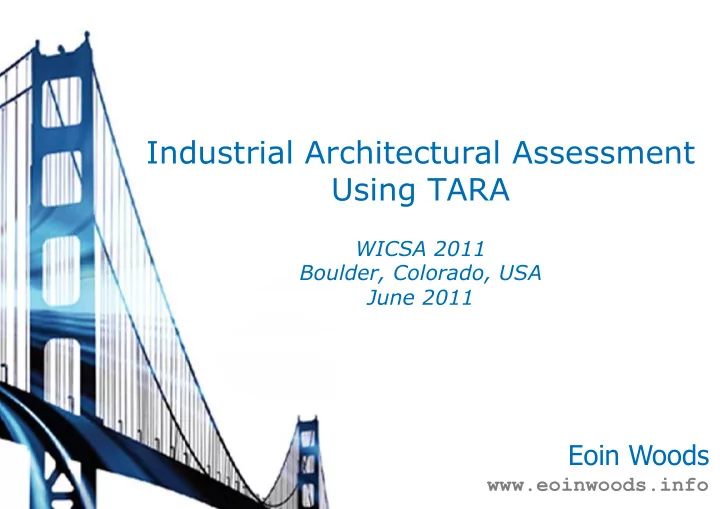

Industrial Architectural Assessment Using TARA WICSA 2011 Boulder, Colorado, USA June 2011 Eoin Woods www.eoinwoods.info
Scenario Based Architectural Assessment • Scenario based assessment has existed “forever” • SAAM was defined in 1994 • Lots of research defining and comparing methods • SAAM, ATAM, SAAMMCS, HoPLAA, ALMA, CPASA, ALPSM • Relatively little use in industry • beyond large defence projects and some public sector ones • Industrial perceptions • expensive, looks complicated, outputs & benefits unclear • needs a lot of input from busy (non-technical) stakeholders • However industry still needs to review architectures • the norm is “ assessment by uninformed debate ” 2
How the Approach was Born • An existing system was perceived as deficient • or at least its “quality” was unknown • A request was made to assess its “quality” • really its suitability for strategic global deployment • The whole process needed to be fairly quick • no expectation of wide stakeholder involvement • one architectural assessor working with the team • ATAM clearly wasn’t going to be accepted • no organisational history of architectural assessment • desire to keep it simple and “lightweight” • So a simpler approach was required • that took implementation artefacts into account 3
The Tiny Architectural Review Approach 1. Context and Requirements 2. Functional and Deployment Views 3. Code Analysis 4. Requirements Assessment 5. Identify and Report Findings 6. Create Conclusions for Sponsor 7. Deliver Findings and Recommendations
Context 5
Example Requirements 6
Functional View Nearly always add a deployment view too; sometimes others (e.g. data flow)
Static Analysis Measurement Implementation ~1150 Java classes and 20 database tables. The Size Java code is approximately 111,300 (raw) lines of code and is ~230,000 Java byte code instructions. Test Size & ~60 Java test classes which reference ~100 Java Coverage classes in the implementation. Structure Code organised into 10 modules and 8 layers, with about 15% of the leaf level packages considered to be “tangled” together. Tangled Code Engine - package com.abc.system.engine (46% of the code tangled); Server - package com.abc.system (42% of the code tangled) and package com.abc.system.service (31% of the code tangled); Base – package com.abc.system (32% of the code is tangled) and package com.abc. system.cuboid.dimension (30% of the code tangled). 8
Example Findings and Recommendations 9
Assessing TARA Itself • Strengths • Simplicity • Implementation structures are a key input • Brings Structure to an otherwise ad hoc situation • Speed and Efficiency • Simple, Concise, Usable Outputs • Weaknesses • Subjectivity of the reviewer • still some ad hoc elements to the process • Lack of (mandatory) trade-off analysis • Primary input is implementation structures • rather than the design artefacts or process • Relatively shallow assessment 10
Comments and Questions? Eoin Woods contact@eoinwoods.info www.eoinwoods.info
Recommend
More recommend